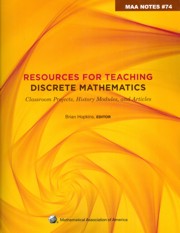Book contents
- Frontmatter
- Introduction
- Dedication
- Contents
- I Classroom-tested Projects
- II Historical Projects in Discrete Mathematics and Computer Science
- III Articles Extending Discrete Mathematics Content
- A Rabbi, Three Sums, and Three Problems
- Storing Graphs in Computer Memory
- Inclusion-Exclusion and the Topology of Partially Ordered Sets
- IV Articles on Discrete Mathematics Pedagogy
- About the Editor
A Rabbi, Three Sums, and Three Problems
from III - Articles Extending Discrete Mathematics Content
- Frontmatter
- Introduction
- Dedication
- Contents
- I Classroom-tested Projects
- II Historical Projects in Discrete Mathematics and Computer Science
- III Articles Extending Discrete Mathematics Content
- A Rabbi, Three Sums, and Three Problems
- Storing Graphs in Computer Memory
- Inclusion-Exclusion and the Topology of Partially Ordered Sets
- IV Articles on Discrete Mathematics Pedagogy
- About the Editor
Summary
Introduction
We present a slice of discrete math history and connect it to three neat problems and their solutions. The solutions emphasize the value of exploring and tabulating data in order to help discover theorems. Often, the exploration not only helps discover theorems, but suggests a direction and idea for a proof.
The methodology is a model of how to use mathematical history and data patterns in teaching discrete mathematics. Proofs in discrete math tend to be constructive. Discovering patterns can suggest an algorithm, which in turn can suggest a proof. Furthermore, many theorems in discrete math make use of basic sums and combinatorial identities that have been known for hundreds of years. Familiarity with the history of an identity can also suggest relevant proof methods.
Underlying the content in this article is the implicit theme of how mathematics and computers support each other. Computers can be used to generate data for pattern searching, or to help with calculations that are otherwise too cumbersome. Symbiotically, these same theorems, whose statements and proofs are motivated by the data gathered with the use of a computer, are themselves applicable to computer science in the analysis of algorithms as well as other areas.
A Rabbi's Identities
Rabbi Levi ben Gershon (1288–1344, also known as Gersonides) lived in southern France and was a well-known scientist, mathematician, and philosopher among both Jewish and Christian scholars of his day [Si1], [Si2]. Levi discovered formulas for certain kinds of sums.
- Type
- Chapter
- Information
- Resources for Teaching Discrete MathematicsClassroom Projects, History Modules, and Articles, pp. 277 - 286Publisher: Mathematical Association of AmericaPrint publication year: 2009



